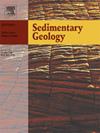Lacustrine sedimentary evidence of cascading mountain hazards at the inner-Alpine Lake Altaussee (Eastern Alps, Austria) during the Late Holocene
IF 2.9
2区 地球科学
Q1 GEOLOGY
引用次数: 0
Abstract
Inner-Alpine or intramountainous lake systems can be formed by glacial, tectonic or landslide processes and typically present complex sediment dynamics that can drastically change over time and can be driven by various natural hazard processes. Their sedimentary archives can therefore provide insights in the past magnitude and frequency of local mountain hazards, which is key for reliable hazard assessment and understanding of mountain landscape evolution. Here we present morphological, seismic-reflection and sedimentary data from Lake Altaussee, a groundwater-fed lake surrounded by steep topography in the Eastern Alps (Austria). The slow organic-rich sedimentation is interrupted by one phase of inflow (by the Augstbach creek), resulting in clastic sediment input between ~1110–1346 cal yr CE. This inflow phase was terminated by an artificial diversion of the creek as documented in historical reports. The combination of large blocks (max. 70 m in diameter), a mass-flow deposit and megaturbidite deposited on deformed basin floor sediments points to multiple terrestrial mass movements with a total volume of ~430,000 m3 that propagated into the lake and which occurred 755–991 cal yr CE. A 3D hydrodynamic model suggests that the potential mass movement at the northern shore induced an impact wave that inundated the western shoreline with flow depth of up to 9 m and reaching up to ca. 210 m inland. Calculated speed of the backflow indicates that coarse shore sediments can be transported into the lake, which can explain the abundance of gravel/coarse sand at the base of the megaturbidite at the periphery of the basin. Moreover, such impact wave would lead to a standing lake water oscillation (seiching), which is further attested by regular lamination and oscillating grain-size parameters at the base of the main silty unit of the megaturbidite. A persistent change in sediment dynamics around a main subaqueous karst spring pit occurred at 165 cal yr BCE–222 cal yr CE when repeated sediment expulsions from the spring pit started to build up a crater rim. This onset of sediment expulsions is directly overlying a soft-sediment deformation structure (micro-faults). A good age correlation of the two major Altaussee events (i: multiple mass movements, ii: onset of sediment expulsions from spring pit) to large mass-transport deposits in the sedimentary record of the nearby Lake Hallstatt let us hypothesize that two large earthquakes took place in the Late Holocene that led to a multitude of morphological and sedimentary responses in the Upper Traun region. Our findings provide the first indication of an impact wave on a natural lake in the Eastern Alps, highlighting the potential for hazard cascades that remain undocumented in historical records, underscoring the need for reassessing natural hazard risks in alpine lake environments.
晚全新世阿尔卑斯湖内阿尔卑斯湖Altaussee(奥地利东阿尔卑斯)层叠山灾害的湖相沉积证据
高山内部或山间湖泊系统可由冰川、构造或滑坡过程形成,通常呈现复杂的沉积动力学,可随时间急剧变化,并可由各种自然灾害过程驱动。因此,它们的沉积档案可以提供当地山地灾害过去的规模和频率的见解,这是可靠的灾害评估和了解山地景观演变的关键。在这里,我们展示了来自阿尔陶湖的形态、地震反射和沉积数据。阿尔陶湖是奥地利东阿尔卑斯山一个被陡峭地形包围的地下水湖泊。缓慢的富有机质沉积被奥格斯特巴赫河(Augstbach creek)的一段流入打断,导致碎屑沉积在约1110-1346 calyr CE之间输入。历史报告中记载,这一流入阶段因人工引流而终止。大块的组合(最大。(直径70 m),在变形的盆地底沉积物上沉积的质量流沉积和巨闪岩表明,发生在公元755-991年的多次陆块运动,总积约43万m3,向湖中扩展。三维水动力模型表明,北岸的潜在质量运动引发了一个冲击波,淹没了西部海岸线,流深达9 m,内陆达约210 m。计算出的回流速度表明,粗岸沉积物可以被带入湖泊,这可以解释盆地外围巨浊岩底部砾石/粗砂丰富的原因。此外,这种冲击波还会引起静湖水振荡(振荡),这一现象在微闪岩主粉质单元底部的层压和粒度参数的振荡中得到了进一步证实。在公元前165年至公元前222年,一个主要的水下岩溶泉坑周围的沉积物动力学发生了持续的变化,当时泉水坑的沉积物不断排出,开始形成火山口边缘。这种沉积物排出的起点直接位于软沉积物变形构造(微断层)之上。在Hallstatt湖附近的沉积记录中,两次主要的Altaussee事件(1:多次物质运动,2:从泉坑开始的沉积物排出)与大型物质搬运沉积的良好年龄相关性使我们假设晚全新世发生了两次大地震,导致了上Traun地区的大量形态和沉积反应。我们的研究结果首次表明,东阿尔卑斯的一个天然湖泊受到了冲击波的影响,强调了历史记录中未记载的危险级联的可能性,强调了重新评估高山湖泊环境中自然灾害风险的必要性。
本文章由计算机程序翻译,如有差异,请以英文原文为准。
求助全文
约1分钟内获得全文
求助全文
来源期刊

Sedimentary Geology
地学-地质学
CiteScore
5.10
自引率
7.10%
发文量
133
审稿时长
32 days
期刊介绍:
Sedimentary Geology is a journal that rapidly publishes high quality, original research and review papers that cover all aspects of sediments and sedimentary rocks at all spatial and temporal scales. Submitted papers must make a significant contribution to the field of study and must place the research in a broad context, so that it is of interest to the diverse, international readership of the journal. Papers that are largely descriptive in nature, of limited scope or local geographical significance, or based on limited data will not be considered for publication.
 求助内容:
求助内容: 应助结果提醒方式:
应助结果提醒方式:


